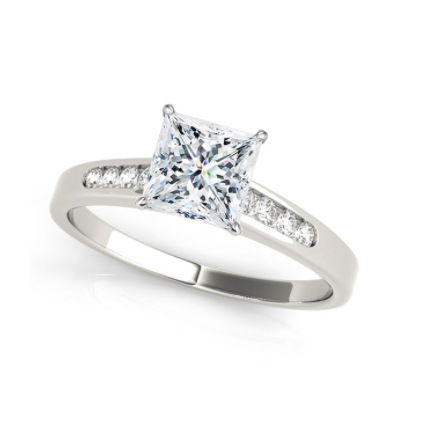- Set a comfortable budget - ignore old "salary rules"
- Master the 4Cs for smart diamond selection.
- Metal and setting choices can enhance the stone
- Get proper ring size secretly via friends or existing rings
- For quality assurance: certified diamonds with grading reports
- Buy on Rare Carat for price, quality, and customer support
“Anyone can catch your eye, but it takes someone special to catch your heart.” Congratulations on finding your perfect soulmate!
Getting engaged is one of the most special moments in a person’s life. And you definitely want to make sure you are doing everything right...especially when it comes to choosing that perfect engagement ring, the most important purchase that will make her absolutely happy and something she’ll cherish for life!
Let’s make buying that important piece of jewelry a pleasant and enjoyable experience for you! To begin making a smart and informed purchase, it’s important to keep the following points in mind:
Deciding on a budget:
There is an old myth that one needs to spend 2-3 months of salary to buy an engagement ring. It is absolutely up to you on how much you feel like spending depending on your budget that's comfortable. The most important aspect is that you are aware and have the knowledge about what you wish to buy and also compare with jewelers or online to get the best one that is within your budget. Ultimately it’s what you buy from your heart that matters most!

Knowledge about the 4C’s:
The most important aspect to understand before choosing a diamond is understanding the 4C’s.
4C’s mean Clarity, Color, Cut and Carat weight of a diamond. A universal standard has been set by the GIA for easily evaluating the quality and pricing of a diamond which helps us in understanding the difference between one diamond and another.
Clarity:
By clarity we mean the presence of imperfections within the diamond called inclusions or external flaws which are called blemishes. You could also refer to them as “birthmarks” as no two diamonds have the same inclusion or blemish.

Color:
Refers to the absence of color in a gem quality diamond, for which GIA follows a grade scale from D-Z (colourless-light color).

Cut:
This refers to how well a diamond is cut so that its facets (outer surface) are able to reflect and refract light optimally which ultimately affects a diamond’s beauty and price.

Carat:
The carat indicates the weight of a diamond and not its size.

Knowing the various diamond shapes and cutting styles:
Diamond shape refers to the outer structure or outline of the diamond. There are 10 main shapes (see below image). On the other hand, diamond cut, or the cutting style of the diamond refers to the placement of the diamond's facets on its surface like brilliant or step cut.

Choosing the right metal to enhance the look of the diamond:
Choosing the right metal plays a significant role as this affects the overall look of the jewelry. Metals such as platinum and white gold are a popular choice because they give a contemporary look. You should consider this especially for diamonds whose color range between D-J as they make an excellent choice and cause the colourless quality of these diamonds to be enhanced. In contrast, if colourless diamonds are set with yellow gold then the diamonds reflect the colour of the gold thus making it look yellowish.

Platinum:
Platinum tends to be more popular than white gold for engagement rings as it’s more durable, rare, and ideal for jewelry that is worn on a daily basis. This metal is highly resistant to stress and can withstand extreme temperatures, which means that it will retain its good look better than any other metal. The only downside of platinum is that it is more expensive than white gold because it is 30 times rarer and mined much less than gold.
Gold:
Gold is the most classic and luxurious choice of metal used in engagement rings. By mixing gold with various other metals, engagement rings can be produced in a variety of colors and at several affordable price points. Gold comes in many levels of purity. Karat (abbreviated to kt) is used to measure the purity of gold.
22kt:
This is 91.6% gold and the rest metal alloy. It's a deep yellow in color but quite rare and not recommended for engagement rings as it is very soft and malleable.
18kt:
This purity has 75% pure gold and 25% other alloy metals. 18kt. gold is more durable and less expensive than 22kt. gold.
14kt:
This is 14/24 gold, or about 58% pure gold and 42% other alloy metals. It's more durable and less costly than 18kt and 22kt gold.
Yellow gold:
Yellow gold is a blend of pure gold mixed with alloy metals such as copper and zinc in certain percentages, giving it 22kt, 18kt, 14kt, etc. purity. Yellow gold is a very traditional color for engagement rings and its impressive yellow color will never change over time.
White Gold:
White gold is an alloy of gold. This means that it is made up of pure yellow gold, mixed with alloy metals such as palladium, nickel and silver, giving it a silvery-white color. It has a warmer hue than platinum and is plated with rhodium to enhance its silvery sheen (which may wear away over time and require re-plating).
Rose Gold:
Rose gold is a blend of pure 24 karat yellow gold, copper and silver alloys. Less gold and a higher copper content gives it a more reddish rose color, which makes many feel more like it's a romantic metal. It complements all skin tones and makes it more durable than other color gold because of the presence of copper.
The ring setting style that would look the best:
After choosing the perfect diamond and metal type for your loved one, the next important step would be to choose a ring setting style that will not only enhance the beauty of the diamond but also protect it from getting damaged.
Most common settings used for engagements rings:
Prong setting:
The diamond is held in position with a minimal quantity of metal, and usually is set in four, six or eight prongs. This is the perfect setting to bring out the beauty of the diamond.

Bezel setting:
In Bezel Settings, the perimeter of the diamond is partially or fully surrounded by a thin metal frame, making it one of the most secure and protected types of settings.

Halo setting:
This is a setting with a small accent (small diamonds placed beside larger stone in jewelry) diamonds, usually pavé diamonds, that surround the center stone.

Channel setting:
Style of setting where the small diamonds are placed in a channel or a groove on the shank of the ring with metal walls, making it a secure option for smaller diamonds.

Know her perfect ring size:
This step seems to be the hardest to accomplish without ruining the surprise, but with our help, it can be done! First, you can ask her (if it's not a surprise) or you can ask her mom/friends/sisters for help. Second, you can use one of her current rings to get an idea. Take it to a local jeweler or look online how to measure the ring size (amazon has inexpensive sizers too). Finally, you can print out our handy dandy ring sizing chart!
If you don't get it right the first time, don't fret, all of our retailers offer a free sizing after purchase. Be sure to ask a gemologist about the retailer you're purchasing from for their exact policy.
Selecting a jeweler:

You can visit a local, family owned store, larger chain store or shop online with our trained, Graduate Gemologists and vetted retailers. The choice is yours, but no matter where you shop, we'll be here to give you a hand along the way.
Make sure the diamond has a grading report:
This is important as the grading report gives you all the exact specs, measurements, color and clarity for the diamond you choose. There's no guessing involved. All of the diamonds listed on our site either come with a GIA report (natural) or IGI/GCAL (lab grown). We've got you covered!
Why should I buy my Engagement Ring on Rare Carat?
Rare Carat is currently ranked #1 on Trustpilot in the “Jeweler” category. Whether you buy lab or natural, whether on a ring, earrings, bracelet, pendant: the reason Rare Carat receives such good reviews is that we protect customers throughout their purchase and genuinely care about customer satisfaction.
We offer 30-day free returns (no fine prints) and 1-Year Complimentary Resizing (One complimentary resizing is included within your first year. Eternity bands are not eligible for resizing after 30 days. Extended coverage is available through our care plan.). We inspect your diamond’s authenticity before it ships, but most importantly, we will start by closely advising you on picking the right diamond. If our gemologist gives you a thumbs up - you can be 100% sure it will be gorgeous in person. Chat with us!
I wish you a very happy engagement purchasing experience! Definitely reach out to our gemologists if you have any questions at all!
To compare real examples across styles and budgets, take a look at Rare Carat’s engagement rings and see how each setting fits these guidelines.

